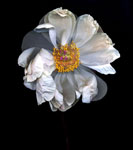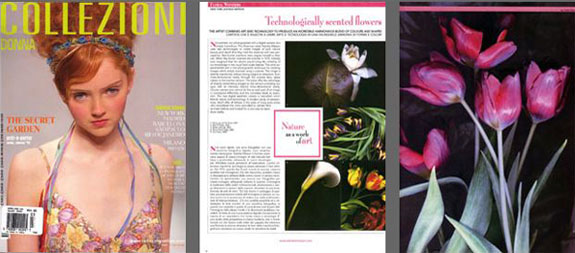|
EXTRAORDINARY
FLOWERS

Katinka
Matson's flowers are magnificent and surreally real.
|

FEUILLETON
SPIDER FLOWERS: Katinka Matson's
Scanner Art Fascinates With Intensive Clarity
Andrian Kreye
August 1, 2005

Ever
since Marcel Duchamp mounted the front wheel of a
bycicle onto a bar stool, the anarchic use of everyday
technologies has been part of the standard repertoire
of Modern Art. Usually such works question our perception
by distorting reality. The flower images by the New
York artist Katinka Matson are different for their
exactness and completeness: the surreal aura of her
pictures come from their enormous clarity. The flowers
seem to radiate from the inside and the details are
recognizable into the last fiber as though they were
being viewed under a magnifying glass.
|

November 26, 2004
PERSONAL
JOURNAL — Time Off — Calendar: Europe's Guide to Leisure & Arts
Activity
AMSTERDAM:
Van Gogh; BILBOA: Raphael, Michelangelo, da Vinci, FLORENCE:
Michelangelo; FRANKFURT: Rembrandt, Gaugin, Degas, Munch;
GENOA: Matson; WARSAW: Kandinsky, Chagall.
GENOA / Art / 'Katinka Matson: Flowers' features incredibly
lifelike images of lilies and tulips, with every drop of dew
and grain of pollen magnified. The works by the American artist
aren't photographs, but were created by placing cut flowers
on an ordinary office scanner and printing high-resolution
images.
Festival
della Scienza, Palazzo Rosso; 8 Via Garibaldi; Until Nov.
28. |

November 5, 2004
PALAZZO
ROSSO Photographic Exhibition of American Artist
The
flowers of Katinka Matson "grow" in the computer
by L. Gu
I
was struck by the formal quality of the images and I was
intrigued by all the implicit connections among the art and
sciences that her work is based upon. Katinka's works are reminiscent
of the works of Mapplethorpe or of Georgia O'Keeffe. They're
also interesting from a botanical point of view because the
technique she uses makes visible a lot of details that would
be otherwise be hard to grasp." [continue...]
|

November
4, 2004
Discovered
in a digital universe
by Haydn Shaughnessy
One
of the highlights of the festival is the first European exhibition
of Katinka Matson, an artist working within the digital aesthetic,
whose work is attracting attention and praise in the United
States...
Joyce,
in Finnegans Wake, joined the same attack on language's
invisible restraints, more with a sense of accomplishment
than with the frustration that isolated Wittgenstein. But
Joyce left us no more enlightened. As with Wittgenstein's
work, the message of Finnegans Wake is ultimately that
we are not sophisticated enough to understand beyond our
linguistic rules.
The Katinka Matson exhibition gives a clue as to where we might look for answers
today. Matson's exhibits are visually compelling still-lifes, produced not through
the physical application of materials (painting, drawing, printing) or photography. [continue...]
|

pret-a-porter
spring_summer 2005
no. 103 (November 2004)
TECHNOLOGICALLY
SCENTED FLOWERS
FLORAL
WONDERS
NEW YORK—KATINKA MATSON

"NATURE
AS A WORK OF ART"
by Clelia Zanni
Not
painted, nor photographed with a digital camera, but simply
marvellous. The American artist Katinka Matson uses new technology
to create images of suchnatural beauty that they instill the
observer with new perceptions...[continue...]
|

October 30, .2004
Three
Exhibitions
In
Palazzo Rosso we come across images realized by U.S. artist
Katinka
Matson:
she sets bunches of freshly cut flowers
on a special scanner. Thus she manages to create images,
with a procedure similar to some extent to Man Ray's gamma
rays. In her glossy color "xerox copies" we admire
sensuously shaped, almost erotic tulips, peonies and lilies
that are reminiscent of Georgia O'Keeffe's paintings. [continue...]
|

October 28, .2004
Guarda
che scienza
Fascinating
cosmic numbers
One of the creations
of the artist American Katinka Matson: the
naturalistic photos of petals, flowers, steles,
fungi and other "objects" are exhibited
at the Festival.
|

October 17, .2004
"Science
Festival: Twelve days dedicated to the pleasures of knowledge
and ingenuity"
by
Annik Le Guerer
Twelve
days dedicated to the pleasures of knowledge and creativity.
This event was all about learning through having fun, and
recognising that the new disciplines must become an integral
part of culture – and of political and business culture
too. Scientific research has nothing static about it; it is
based on, and for, continuous change, the constant proposal
of concepts and paradigms. This spirit must be recovered by
the entire productive system, otherwise it will miss the train
of progress.
|

May
29, 2003
Scan
Your Eyes Across This
By Dan Dubno
See
CBS News Video & "Photo Essay" on Katinka
Matson's Art
Katinka
Matson, an amazing digital artist, merging the technological
with the botanical in a beautiful way.
This
Manhattan-based artist unlocked the simple elegance of nature.
Without cameras or special lenses, Katinka Matson captures
the unfiltered raw vibrancy of lilies, tulips, and daisies.
Closer to painting with nature than to containing and "capturing"
it, Ms. Matson’swork is raw, striking, if not shocking.
There is honest power in this fusion of technology with n
ature and it’s made possible by an inkjet printer and
a humble scanner.
|

December
15, 2002
THE
YEAR IN IN IDEAS—2002
Scanner
Photography
by Paul Tough
As
the moving lens slides along the surface of one of Matson's
tulips, it is able to view the flower from all sides; her
floral pictures are so intense that looking at them, you almost
get the feeling that you are able to peer around the flowers
themselves. Another advantage: the distortion that a single
lens inevitably creates disappears—details at the corners
of these pictures are as sharp and clear as those at the center.
[continue...]
|

17.12.02
Flowers, phtographic art with the scanner
Is
there such a thing as an aesthetics of the digital technology,
whether hardware or software? Often the answer is affirmative,
as when one analyzes the work of Katinka Matson, American
artist, who has succeeded in extracting a full poetics from
the skilful use of the scanner. Her floral compositions, visible
on the site at a decent resolution, show not only petals,
stems and pistils but the rhythm and depth that they can express
if arranged in a certain position, revealing an identity unsuspected
to a naturalistic approach.
|
|